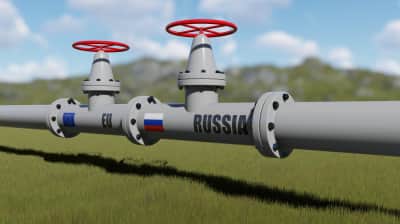Russian Central Bank assets blocked. What does it mean? - Analysis
TUESDAY, 1 MARCH 2022, 09:00 – YAROSLAV VINOKUROV
In the list of ‘lethal’ sanctions against Russia, there is a sanction on the Central Bank. What consequences will this have for the Russian economy and people?
Ukraine unites the whole world around it.
Russia’s treacherous attack on Ukraine on the night of February 24 created a global anti-Putin coalition, which has initiated hard sanctions against the aggressor and its economy. These sanctions have been supported even by countries loyal to the Russian president.
What has been seen as the toughest possible sanction is the expulsion of Russia from SWIFT. The expulsion of the entirety of Russia from SWIFT could have strongly impacted not only ordinary Russian people, who would be barred from cross-border transactions, but it also would have impacted the whole Russian economy’s export and import operations.
Yet in the final decision on SWIFT the sanctions are moderate: only a couple of big Russian banks will be disconnected from SWIFT, enabling Russia to continue international trade. Instead, additional limitations on the Central Bank of Russia were added to the list of rigid sanctions against the country. What consequences will it have for the Russian economy and the welfare of the ordinary people?
An airbag
Central Bank reserves are the currency savings, which can be used to adjust the exchange rate of the national currency. In case of a devaluation of the national currency, the central bank sells foreign currency from the reserves to meet the existing demand for it in the economy.
On February 24, when the open war against Ukraine started, the dollar exchange rate in Russia went up. Investors, companies, and Russian people, afraid of sanctions and war-related economic shock, started buying dollars.
In the first hours of trading, the rate of dollar in Russia increased to 90 rubles per dollar, but later the exchange rate was stabilised to 83 rubles. The latter was achieved with the help of interventions by the Central Bank of Russia.
Additionally, the international reserves are required to pay for the currency debt of the government, ensuring solvency of the state for its creditors.
Before the war, Russia was able to grow international reserves reaching up to 630 billion dollars as of February 1, which is 21x times that of Ukrainian reserves.
What sanctions are related to reserves?
On February 27, the EU decided to impose a new package of sanctions against the Russian economy, including blockage of the operations related to the management of Central Bank reserves.
In other words, Russia no longer has the possibility of using its ‘financial airbag’: the Central Bank of Russia cannot sell its currency assets from the accounts in European banks to save the ruble from devaluation.
On the following day the United States, Japan, and Great Britain joined the sanctions, as well as traditionally neutral Switzerland.
As a result, Russia lost access to the part of its reserves in the West, in Japan, and in almost all other currencies apart from Chinese yuan.
Not everything will be blocked
Gold and foreign exchange reserves are not only in the form of foreign currency and monetary gold. Central banks place their savings in securities with the highest credit ratings (such as US Treasury bonds) or on bank deposits.
However, the Central Bank of Russia has been preparing for western sanctions since the annexing of Crimea. In the last few years, the bank shortened its assets in dollars, increasing the share of assets in Chinese yuan and gold.
The Central Bank of Russia does not provide data on the structure of the reserves on a regular basis. The most recent data was published on June 30, 2021. Then only 16.4% of the Russian reserves accounted for were in dollars, the share of the euro was 32.3%, 13.1% in yuan, 6.5% in pounds, and 21.7% in gold. The rest accounted for assets nominated in other currencies.
When preparing for the war against Ukraine, Russia could have decreased their dollar and euro reserves even more, growing the share of gold and Chinese currency. As of summer 2021, a third of the Russian reserves are protected from the western sanctions.
Michael S. Bernstam, a researcher at the Hoover Institution at Stanford University, estimates that western sanctions will impact around two third of the Russian reserves. This is equivalent to 400 billion dollars of funds which would not be available for the Russian Central Bank to mitigate ruble devaluation.
The rest of Russian reserves, including gold and Chinese yuan, are not so liquid, and could not be effectively used for the urgent replenishment of the additional currency demand.
Potential outcomes
In the last few days the Russian economy has been in a panic. People are withdrawing money from ATMs and buying dollars while it's still possible. As a result, the ruble exchange rate is falling. Despite the official rate being 90 rubles per dollar, in the cash market American currency is sold at 130-150 rubles.
Aiming to hold the balance, the Russian Central Bank has implemented administrative restrictions. Russian exporters, for instance, were obliged to sell 80% of the currency in the market.
The measures can hardly restrain the Russian economy from further falling, nor protect Russian people from impoverishment. The Russian Central Bank has lost 2/3 of its reserve capacity and cannot efficiently cope with the panic of the last few days. Having less reserves, Russia will have to refuse currency exchange rate support to ensure the repayment of foreign debt.
It is hard to estimate the depths to which the Russian currency can fall under these conditions. But we can clearly say that it is possible to see the rate of the ruble at 200.
Have sanctions against Central Banks ever been implemented before?
In terms of past sanctions on central banks, Russia has joined a global club of ‘leading’ economies: Iran, Syria, Venezuela, and Afghanistan. The last large case of sanctions was in response to the Taliban’s seizure of power in Afghanistan. On this occasion, the USA froze all central bank accounts, worth several billion dollars.
The Central Bank of Iran has been under sanctions for more than 20 years. Apart from 2 billion dollars blocked on the accounts at City, the United States also threatens to impose sanctions against anyone who will cooperate with the Iranian Central Bank in the future.





